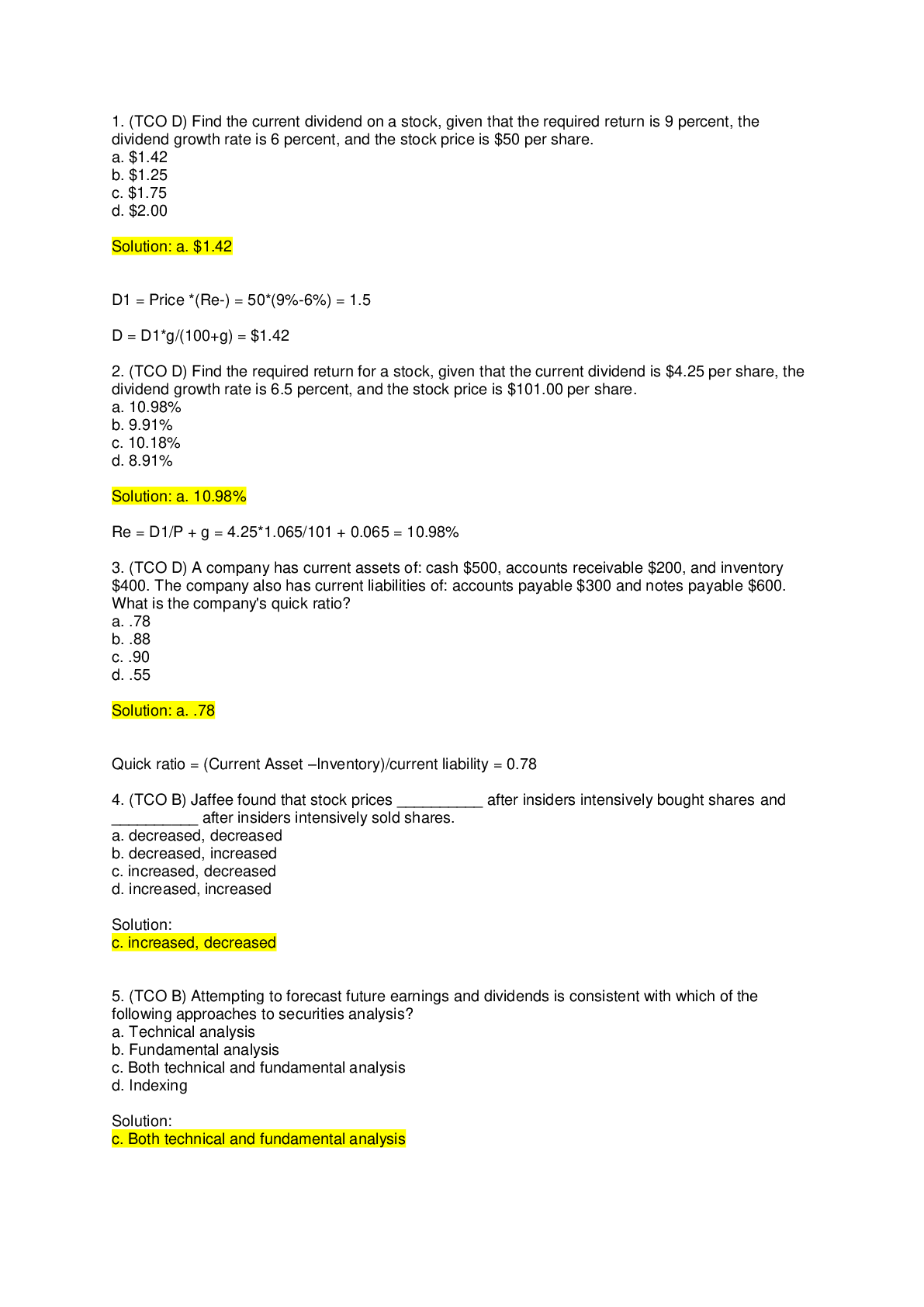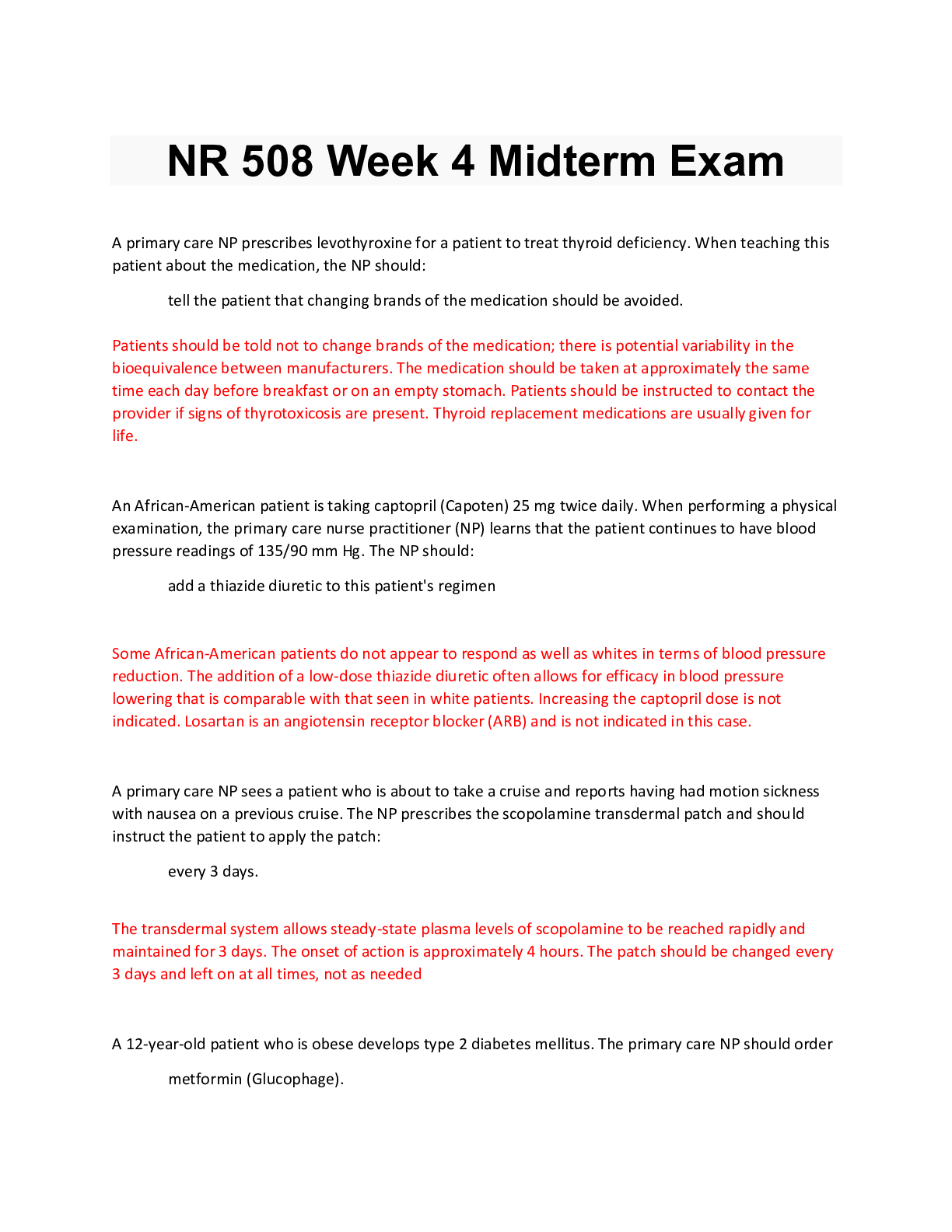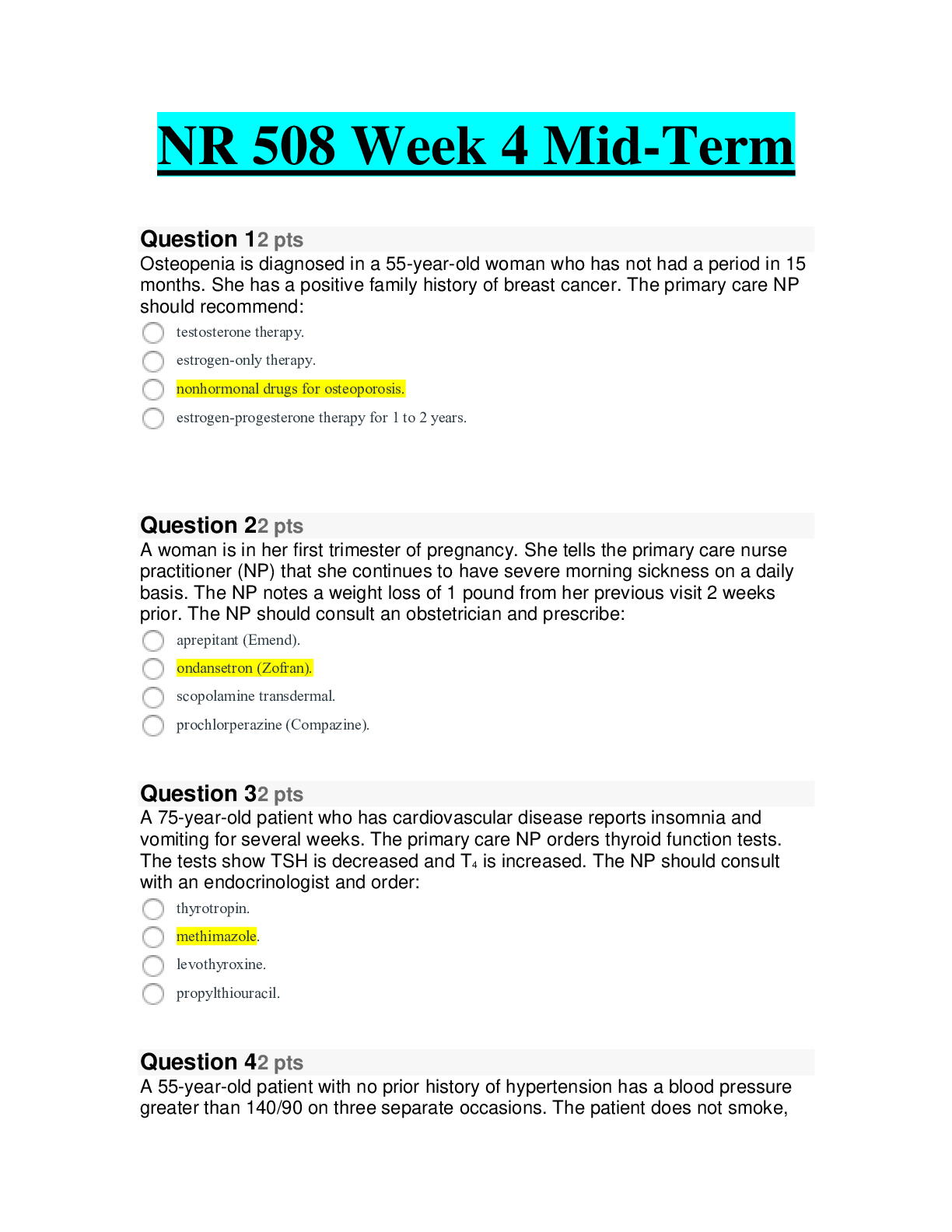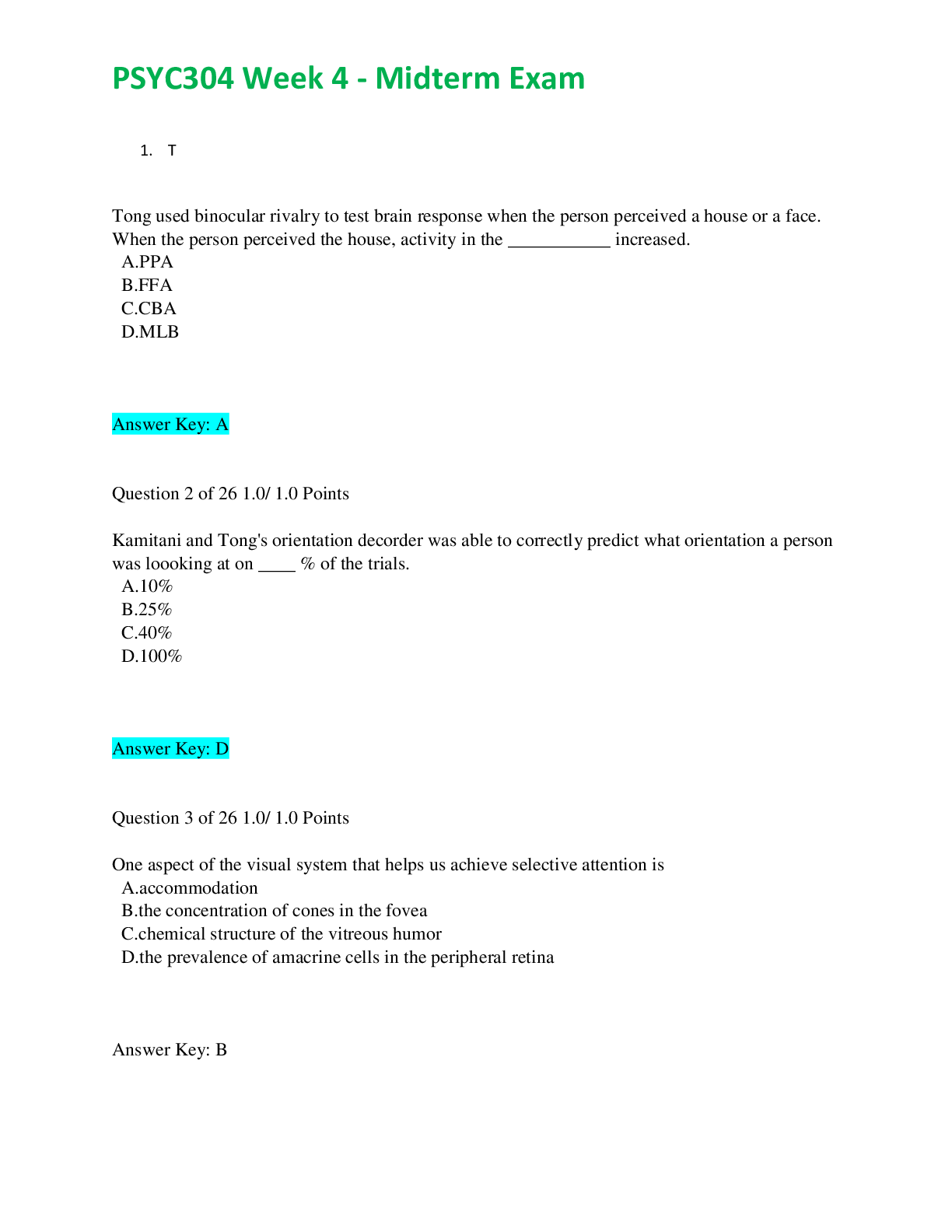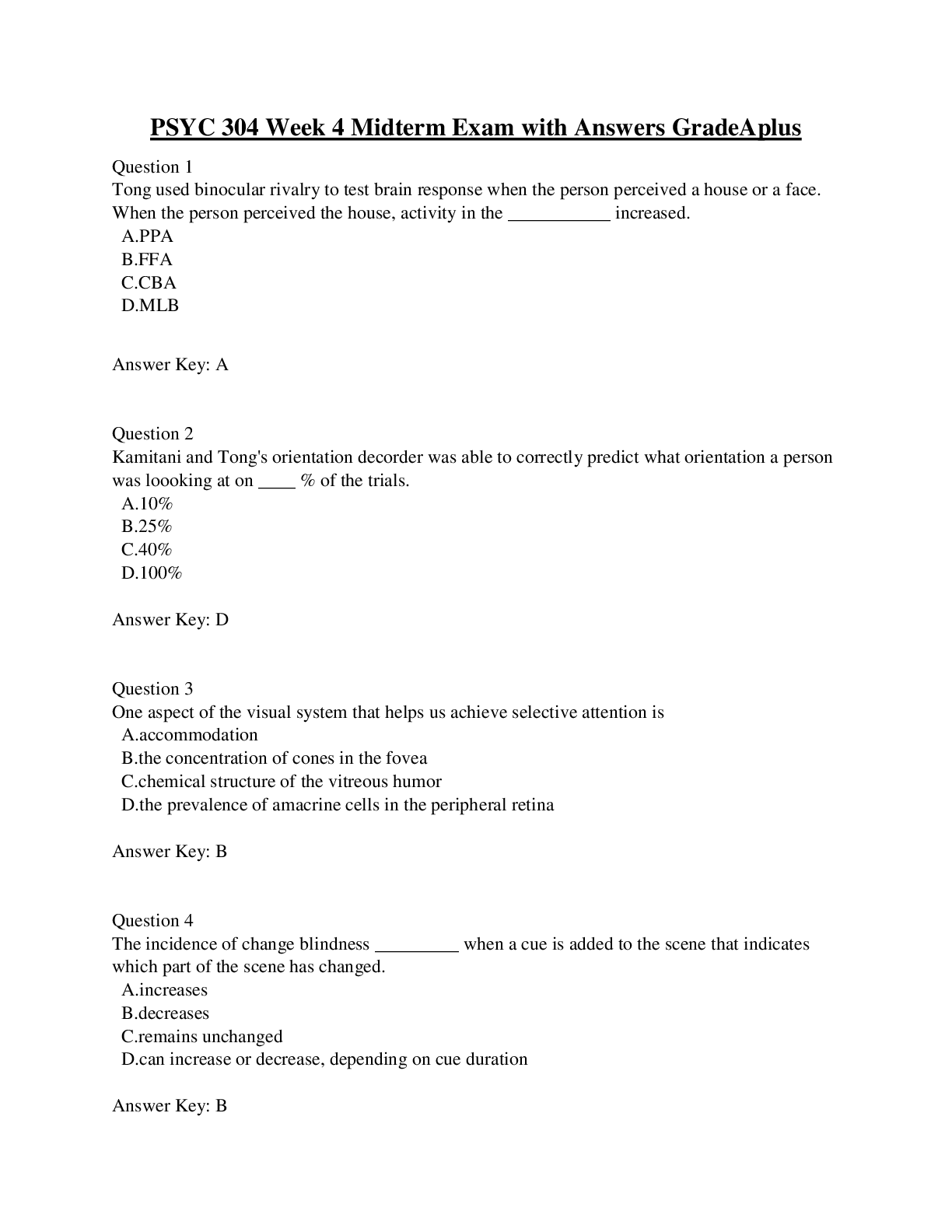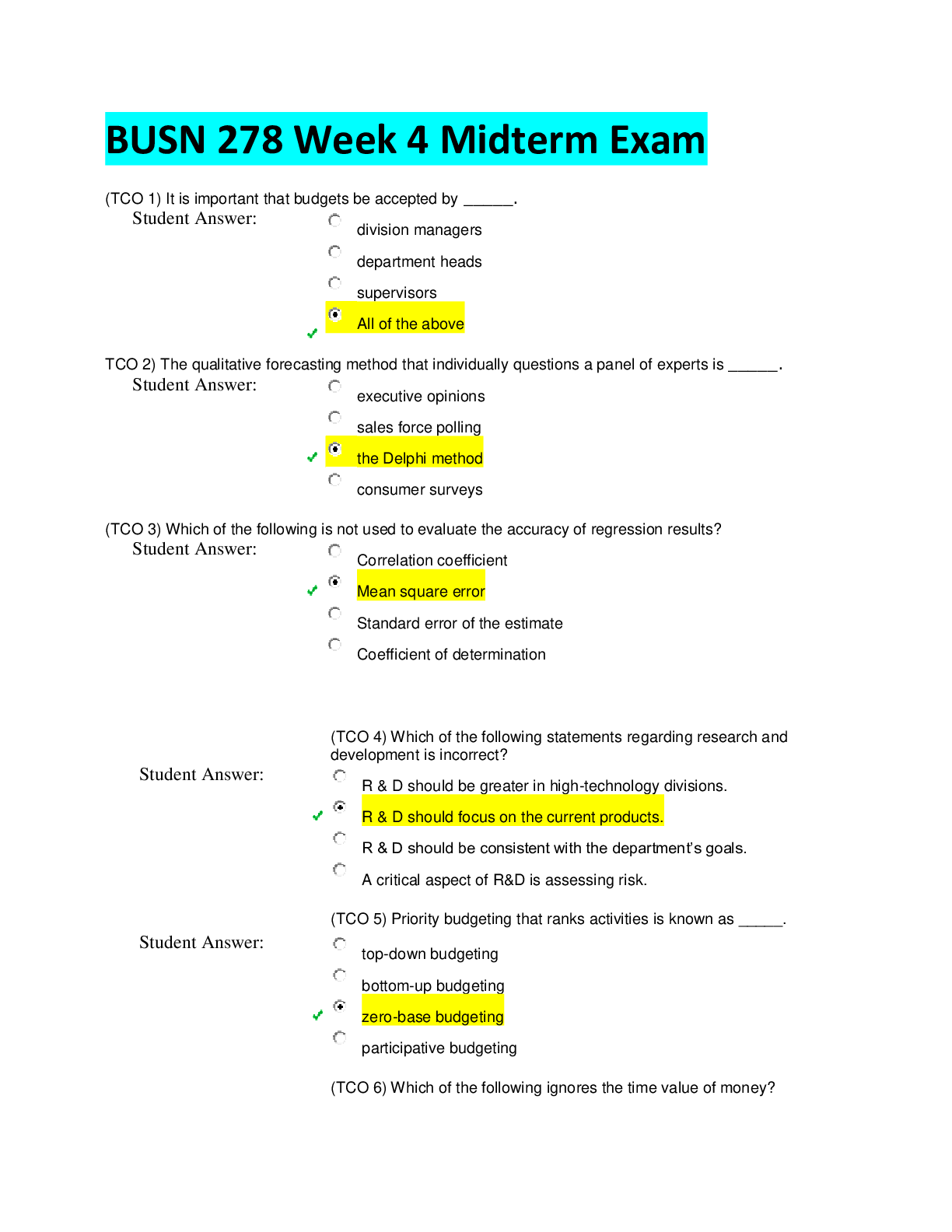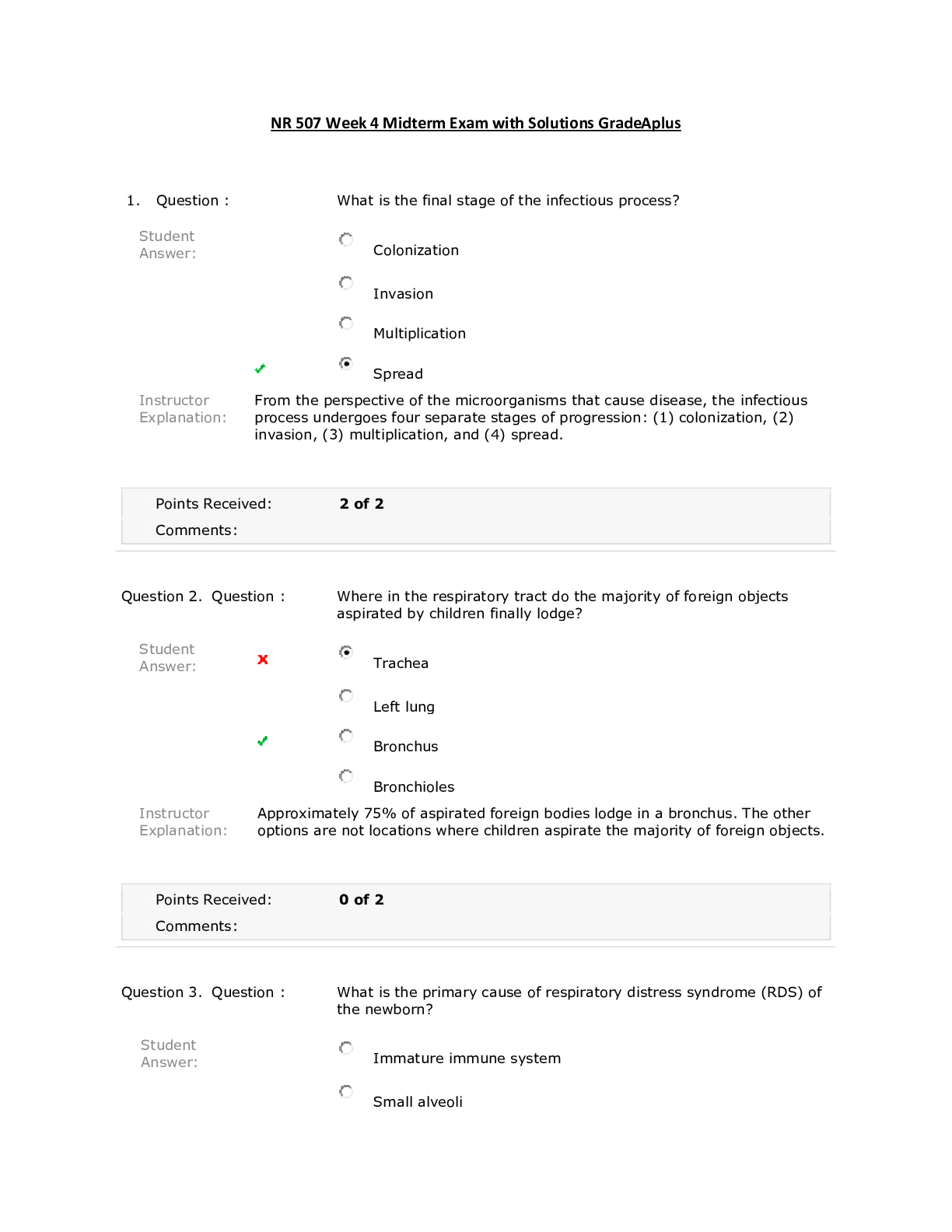NR 508 Week 4 Midterm Latest 2022/2023,100% CORRECT
Document Content and Description Below
NR 508 Week 4 Midterm Latest 2022/2023 Roles and Responsibilities of APRN 1. All states have title protection for NP 2. All but 5 states stat's board of nursing control practice and licensure. ... 3. Scope of practice determined by individual NP license of licensing jurisdiction.New prescribers must know the rules 4. in 17 states, NPs have independent scope of practice and prescriptive authority. 5.6 states have full autonomous practice and prescriptive authority. Clinical Judgement in prescribing 1. Best therapy 2. Least expensive 3. Least likely to cause ADR 4. Clear indication for drug? 5. Are drugs effective in treating disorder? 6. What is goal of therapy? 7. Under what conditions is it determined that drug is not meeting goal and change should be made? 8. Unnecessary duplications? 9. OTC be just as useful? 10. Cost? Collaboration with other prescribers 1. Physician: can offer insight 2. Pharmacists: pharm knowledge 3. Other APRNs: clinical experience shared and collaboration 4. PAs 5. RNs. Autonomy and prescriptive authority 1. More states are broadening and expanding legal, reimbursement, and prescriptive authority. 2. Gains can be reversed, so address concerns. 3. Some push for physician control. Alpha2Agonists: MOA 1. Activation of central alpha 2 receptors results in inhibition of cardioacceleration and vasoconstriction centers in brain. 2. Lead to decrease in peripheral outflow of norepinephrine which leads to decrease in: a. peripheral resistance b. renal vascular resistance c. heart rate d. blood pressure 3. Decrease in BP is due to sympathetic function therefore sodium retention and increased blood volume may occur: give with diuretic. 4. Second or third line HTN drug treatment. Alpha2Agonists: Drugs in class 1. Clonidine 2. guanabenz 3. guanfacine 4. methyldopa. Alpha2Agonists: Clonidine, off-label use Tx of withdrawal d/t ability to lower adrenergic stimulation associated with withdrawal. Alpha2Agonists: ADRs Oral and transdermal doses: bradycardia, AV block, palpitations, tachycardia, hallucinations, sleep disorders, contact dermatitis, dry mouth, orthostatic hypotension, constipation, nausea, urinary retention, decreased sexual activity, weight gain, leg gramps, and thrombocytopenia. MOST COMMON: dry mouth Alpha2Agonists: Discontinue instructions Do not stop abruptly d/t lack of alpha 2 receptors impair homeostatic balance that regulates SNS: Gradual taper over 4 days. Alpha2Agonists: Guanabenz and guanfacine 1. Used to treat HTN. 2. EXR guanfacine: ADHD Alpha2Agonists: Methyldopa 1. Parallels synthesis of norepinephrine (NE) 2. Stimulation by this metabolite: decrease in sympathetic outflow to the heart, kidneys, and blood vessels. 3. End result: decreased in BP, peripheral resistance, HR, sl. decrease in CO. Produces renal vascular resistance. 4. Positive coombs test 5. Rarely hemolytic anemia. Beta-adrenergic antagonists: affects on body systems 1. Heart: Highest of receptors are in heart: decreased HR in rapid rhythms, angina, BP, reflex orthostatic tachycardia. 2. Renal: Receptors in juxtaglomerular apparatus of kidney reduces release of renin. Decrease in BP. 3. Respiratory: Receptors interfere with endogenous adrenergic bronchodilator activity therefore increase airway restriction which is problem in pt with reactive airway diseases like asthma. 4. Ocular: Decrease intraocular pressure. 5. Metabolic and endocrine: Inhibit lipolysis resulting in increased TG and Cholesterol and decreased HDL. Also increased glucose production and inhibits insulin secretion. Beta-adrenergic antagonists: ADRs Usually mild and transient and rarely require d/c of drug. 1. Cardiovascular: Bradycardia, CHF with pulm edema, hypotension 2. CNS: Decreased O2 to brain d/t hypotension, anxiety, depression, drowsiness, insomnia, nightmares, mental status changes. Esp seen in older adults. 3. Endocrine: Hyper/hypoglycemia, unstable DM. 4. Gastrointestinal: Dry mouth uncommon but maybe. Changes in GI motility: anorexia, n/v, flatulence, constipation. 5. GU: Impotence or decreased libido. 6. Resp: Bronchospasm and dyspnea. Nasal stuffiness. 7. Less common: muscle and joint pain, rashes, facial swelling. Beta-adrenergic antagonists: Abrupt withdrawal 1. May precipitate life-threatening arrhythmias, hypertension, MI, severe angina, and death. 2. Taper by one-half every 4 days. Beta-adrenergic antagonists: Absorption and distribution 1. Well absorbed and distributed 2. Crosses: placenta and breast milk 3. Lipid solubility determines CNS penetration. Beta-adrenergic antagonists: metabolism and excretion 1. Metab extensively by liver and eliminated by bile and feces. 2. Dosage adj in hepatic impair. 3. Nebivolol: larger percent of pop: extensive metabolizers-half life 12 hours. Sm. percent of pop: poor metabolizers-half life 19 hrs. 4. Some require dose adjust in renal (atenolol, nadolol, nebivolol, acebutolol). Beta-adrenergic antagonists: precautions and contraindications 1. Contra: respiratory conditions with bonchospastic component, AV block 2. Caution: Older adults, DM, pregnancy, breast feeding 3. No precautions: Hyperthyroidism, children Beta-adrenergic antagonists: Angina Atenolol, metoprolol, nadolol, propranolol 1. Reduce MOD, drug of choice in exertion angina. 2. Do not increase MOS. 3. Start and increase slowly to reduce ADRs. 4. Dosage adjust in renal and hepatic. Beta-adrenergic antagonists: HTN Atenolol, metprolol, nadolol, propranolol (can have propranolol with HCTZ) 1. Initial is with a diuretic. 2. Can be used in combination 3. Pindolol and Acebutolol have few myocardial depressant effects and don't increase cholesterol or TG levels. 4. Renal dosing required. Beta-adrenergic antagonists: Post MI prophylaxis 1. Decreases mortality by 30-40%. 2. Atenolol, metoprolol, propranolol, and timolol Beta-adrenergic antagonists: Migraine Headaches 1. MOA: prevention of beta receptor-induced vasodilation and promotion of incrased extracellular levels of serotonin. 2. Propranolol: should be effective in 4-6 wks. Gradually withdrawal. Muscarinic Agonists: MOA 1. Receptors located: eye, heart, blood vessels, lung, GI, Bladder, sweat glands. 2. Release of ACh from PNS nerves: 1. activates muscarinic receptors on target organs to alter organ fx. 2. activates muscarinic receptors on nerve terminals to inhibit release of their neurotransmitters. 3. Drugs in this class: ACh, Carbachol, pilocarpine, bethanechol, methacholine. Muscarinic Agonists: Treatment uses 1. Glaucoma 2. Improve GI and urinary bladder tone ACh: short-acting, limited to pupil dilation for ophthalmic surgery Methacholine: diagnosis of bronchial airway hyper-reactivity Carbachol and pilocarpine: glaucoma Pilocarpine: oral form: salivary gland secretion treatment for xerostomia from radiation. Bethanechol: increases tone of detrusor urinae muscle: produces contractions strong enough to initiate micturation and empty the bladder. Stimulates gastric motility as well, increasing gastric tone and restoring rhythmic peristalsis. Anorexiants: precautions and contraindications 1. Caution: pt w/ hx of alcohol/drug dependancy-->High risk of tolerance and dependence. 2. Combo alcohol and anorexiant: depression, paranoia, and psychosis. 3. Use should be limited to 6 mos and d/c at any sign of intolerance. 4. Contraind: in pt who abuse: cocaine, phencyclidine, and methamphetamine 5. Pt with diabetes may have altered insulin or oral hypoglycemic dosage requirements. 6. Lorcaserin: serotonergic drug-->may develop serotonin syndrome or neuroleptic malignant syndrome-like reactions if coadmin with serotonergic drugs.-->preg X and not approved for children under 18yrs. Iminostilbenes: Metabolism and excretion Carbamepine: metob in liver and may induce own metabolism (autoinduction) in which therapeutic levels may fall despite good compliance. Also induces metab of CYP450 enzymes. Excreted in urine and feces. Oxcarbazepine: active metabolite is responsible for drug effects. 95% excreted in urine, 4% in feces and 1% and unmetabolized. Does not autoinduce metabolism. Iminostilbenes: MOA Thought to affect sodium channels, slowing influx of sodium in the cortical neurons and slowing spread of abnormal activity. Depresses transmission in nucleus ventralis anterior of thalamus which is associated with spread of seizure discharge. Other effects without sodium channel activity: anticholinergic, antidiuretic, antidysrhythmic, and antidepressant activity. Iminostilbenes: Absolute Contraindications 1. Hypersensitivity to carbamazepine or TCAs 2. Hx of bone marrow suppression 3. Concurrent admin with MAOIs. 4. Tertogenic defects have occurred. Oxcarbazepine: only contraindication: hypersensitivity to oxcarbazepine. Iminostilbenes: Black Box Warning Dermatological reactions especially among asian ethnicity. Stevens-johnson syndrome toxic epidermal necrolysis Also could cause blood dyscrasias (d/t bone marrow depression): aplastic anemia agranulocytosis leukopenia thrombocytopenia Asia ethnicity: should be screened for presence of HLA-B*1502 genetic variant first. Iminostilbenes: Precautions 1. Pt with increased intraocular pressure 2. Hx of previous adverse hematological reactions to any drugs 3. pt with cardiac, renal, hepatic impairment. Iminostilbenes: monitoring 1. Baseline: CBC, chemistry, lft, tsh. 2. Follow-up studies more frequent initially, then every 3-4 mos if results remain normal. Serum sodium levels. 3. Seizure activity monitoring. 4. Monitor for ADRs esp. depression/suicidality 5. Plasma carbamazepine levels. (oxcarb doesn't require levels) Iminostilbenes: ADRs 1. Black box warning for skin and blood problems 2. Hepatic damage 3. Impaired thyroid function 4. Less serious: drowsiness, dizziness, blurred vision, atazia, n/v, dry mouth, diplopia, headache. 5. Most common in oxcarb: dizziness, diplopia, somnolence, fatigue, n/v, ataxia, abd pain, tremor, dyspepsia. 6. May experience hyponatremia esp. in first 3 mos. Iminostilbenes: Drug interactions 1. Most significant are those that increase serum drug levels of carb. as in: propoxyphene, hydantoins, cimetidine, some abx, isoniazid, verpamil. 2. Hepatic damage when taken with: anesthetics and isoniazid. 3. Decrease drug levels with: BBs, succinimides, valproic acid, warfarin, haloperidol, doxycycline, nondepolarizing muscle relaxants. 4. Grapefruit juice increases serum levels. 5. Oxcarb: can inhibit CYP2C19 and induce CYP3A4/5. Can decreased hormonal contraceptives effectiveness containing estrogen. Succinimides: MOA Decreases nerve impulses and transmission in the motor cortex. Increases seizure threshold and reduces electroencephalogram spike-and-wave pattern of absence seizures. Succinimides: Monitoring 1. Plasma levels (methsuximide therap range: 10-40; over 40 toxic) (ethosuximide: therap. 40-100; over 150 toxic) 2. Seizure activity 3. Periodically for ADRS: Liver, renal, and hematological studies Drugs that effects GABA: monitoring 1. Seizures: freq., duration, severity 2. Mood changes, depression, anxiety, suicidality 3. Gabapentin, topiramate, tiagabine: no routine drug levels needed 4. Topiramate: serum electrolyte and sodium bicarb at baseline and periodically, weights, body temp and ability to sweat, serum ammonia (in those with change in LOC, lethargy, vomiting). Drugs that effects GABA: ADRs Gabapentin: Most common: somnolence and dizziness. In children: neuropsychiatric ADRs. Topiramate: ataxia, parathesia, dizziness, somnolence, difficulty concentrating. Children: somnolence and fatigue. increase risk of kidney stones, hyperammonemia. Tiagabine: CNS symptoms. Drugs that effects GABA: Gabapentin Precautions/contraind 1. Hypersensitivity 2. Do not abruptly d/c. 3. Children3-12 have had neuropsychiatric events 4. Not established in children less than 3. 5. Can increase suicidal behavior: caution and monitor. 6. Preg C, caution in nursing. Drugs that effects GABA: Topiramate precaut/contraind 1. Decreases sodium bicarb in blood and can easily lead to metabolic acidosis in infants. 2. Ocular syndrome: acute myopia and angle closure glaucoma. 3. Rare: oligohidrosis and hyperthermia. Caution in exercise in heat and when using other drugs that affect heat-related disorders. 4. Increase suicidal behavior. 5. Do not stop abruptly 6. Preg D, excreted in breast milk. Drugs that effects GABA: Tiagabine precaut/contraind 1. Contra: Hypersensitivity 2. If prescribed without seizure disorder, could cause a seizure. 3. Increase suicidal risk 4. Preg C, excreted in breast milk. 5. Not labeled for children younger than 12. Drugs that effects GABA: Patient education 1. Missing a dose may increase risk of seizures 2. W/drawal seizures may occur if stopped abruptly. 3. Warned about potential neuropsychiatric ADRS like suicidality and behavioral changes. 4. Also warned about potential somnolence, dizziness, balance issues. 5. In topiramate: monitor ability to sweat and temperature in warm weather; and possible increased ammonia levels (confusion, vomiting, mental status change). 6. Get adequate sleep and exercise and avoid stress. Lamotrigine: drug interactions 1. Many drug interactions 2. Oral estrogen-containing contraceptives decrease lamotrigine levels by 50%. Lamotrigine may decrease levonorgestrel levels by 19%. 3. Rifampin decrease Lam by 40%. 4. MOST CONCERNING: valproate: when admin concurrently, increased risk of life-threatening rash, such as stevens-johnson. Valproate increase Lam by more than 2-fold. Tricyclic Antidepressants: precautions and contraindications 1. Contra: cardiovascular disorders 2. Risk in cardiac conduction disorders: highest risk: children and elderly. 3. Caution: glaucoma, prostatic hypertrophy, or urinary incont. 4. Not prescribed with MOAIs or those with hypersensitivity. 5. preg c; excreted in breast milk. 6. Tardive dyskinesia and neuroleptic malignant syndrome reported and more likely with amoxapine. 7. Titrate gradually 8. can lower seizure threshold. 9. Precaution in depression and suicide as energizing effect can precede follow through of suicidal plan. 10. Caution in elderly. MAOIs drug interactions 1. Hypertensive crisis can occur if given concurrently with food or drugs that raise BP. Like: anticholinergics, sympathomimetics, stimulants, and foods with tyramine (aged or fermented foods). Avoid foods during drug therapy and for 14 days afterwards. Drugs to avoid with MAOIs Anorexiants Venlafaxine SSRIs Bupropion bromocriptine l-dopa l-tryptophan MAO-B inhibitor sumatriptan Drugs used cautiously with MAOIs CNS depressants meperidine antipsychotics Drugs to avoid with amphetamines TCAs SSRIs SSRI: ADRs 1. Usually relatively minor and transient 2. Most common: nausea, sometimes vomiting, headache, light-headedness, dizziness, dry mouth, increased sweating, weight gain or loss, exacerbation of anxiety, agitation. 3. Sexual side effects occur in 35%: changing dosage or drug may help. 4. Significant: serotonin syndrome. Especially with adjunctive combinations. 5. When making change: allow for 5 half lives per dose decrease. 6. Significant withdrawal syndrome 7. Fluoxetine has long half life so no withdrawal. Symptoms of serotonin syndrome Nausea diarrhea chills sweating hyperthermia HTN myoclonic jerking tremor agitation ataxia disorientation confusion delirium can progress to coma and death SSRIs in children Fluoxetine: major depression children 8-17; OCD children 7-17. Escialopram: major depression children 12-17 Fluvoxamine: OCD children 8-17; not approved for depression in children Paroxetine: not approved for use in children Serraline: OCD children 6-17; but not for depression or panic Vortioxetine: not studied in children or adolecents. SSRI: drug interactions 1. Do not take with MAOIs (wait 14 days to washout) 2. Drugs that inhibit P450 2D6 will increase effect 3. Alcohol, antihistamines, opiods: CNS depression 4. St. John's wort and/or SAMe-serotonin syndrome 5. Do not prescribe with TCAs and require wash out. SSRI patient education 1. Takes 3-4 weeks for full effect 2. Initial ADRs should be minor and transient 3. Assess level of sedation drug causes before engaging in hazardous activities. 4. Caution of withdrawal and missing a dose. Chronic stable angina/low risk unstable angina: Beta Blocker: DM BBs decrease insulin secretion and may mask signs of hypoglycemia. One sign not masked: diaphoresis--should test blood sugar when diaphoretic! Beta1-selective drug reduces risk of this blockade. Angina: effect on concomitant diseases: CCBs`` Dihydropyridines: Favorable: HTN, Isolated systolic HTN, Systolic HF, Raynauds, PVD Unfavorable: Peripheral edema Verapamil Favorable: A-tach, HTN, migraines, MI Unfavorable: Advanced AV block, Constipation, HF, Concurrent use with BB Diltiazem Favorable: A-tach, DM, MI Unfavorable: Advanced AV block, HF Amlodipine Favorable: Atherosclerosis, HF Unfavorable: Angina: effect on concomitant diseases: Statins Favorable: Hyperlipidemia, HTN Unfavorable: Pregnancy, myopathy hx Angina: effect on concomitant diseases:DRIs Favorable: HTN Unfavorable: Pregnancy, Bilat. renal art. sten., angioedema Hx Angina: effect on concomitant diseases: ACEIs Favorable: DM, HF, Hyperlipidemia, HTN Unfavorable: Pregnancy, Bilat. renal art. sten., angioedema Hx Angina: effect on concomitant diseases: BBs Favorable: HR, Arrhythmias, a-tach, HTN, Stage fright, Migraines, Hyperthyroidism Unfavorable: Advanced AV block, Uncontrolled/severe reactive airway disease, claudication/raynaud's, DM Angina: effect on concomitant diseases: Nitrates Favorable: HF, HTN Unfavorable: Migraines, MI HF Drugs: Stage A 1. Reversing underlying pathologies and treating precipitating factors. 2. Lifestyle mods. 3. Control BP (ACEIs or BBs) and lipids 4. Control blood sugar. HF Drugs: Stage B 1. Structural heart disease w/out symptoms. Asymptomatic LV dysfunction (ALVD). 2. At high risk for developing HF. 3. First drug of choice: ACEIs. 4. Beta blockers (Bisoprolol, carvedilol, metoprolol succinate) now added regardless of previous HTN med reg. 5. No digoxin at this stage unless rate control is needed. HF Drugs: Stage C 1. First stage with active HF symptoms. 2. Moderate sodium restrict, daily weights, physical activity as tolerated encouraged. 3. Combo of three druges: ACEIs, BBs, Cardiac glycosides (digoxin), and a diuretic. HF Drugs: Stage D 1. ACEIs and BBs still suggested. But may only tolerate small doses. 2. ACEIs and BBs not to be initiated in this stage. 3. Management of fluid status (strict management) 4. Addition of second diuretic may help in addition to sodium monitoring. ACEIs MOA in HF 1. Improve symptoms, decrease morbidity, and increase life expectancy. 2. Affect preload and afterload--vasodilation, decrease incidence of remodeling, and prevent neurohormonal counterregulatory mechanisms. 3. Pt on ACEIs mod increase in EF, decreased LVED filling pressures and improved myocardial energy metabolism. 4. Superior to all others to treat heart failure esp. LVSD. First line therapy of choice! First line drugs of choice in HF 1. Diuretic in fluid overload: Furosemide 2. ACEIs (captopril, enalapril, lisinopril, quinapril) Indications for BBs in Heart Failure 1. Recent or remote history of MI regardless of EF or presence of HF. 2. Started in stage I to decrease HTN and prevent HF. 3. In stage B started regardless of HTN med reg. 4. Recommended for all patients without hx of MI who have reduced EF (less than or equal to 40%) w/ no HF symptoms. 5. Those with diastolic dysfunction or cardiomyopathies for whom decreased heart rate could improve CO. Drugs that increase life expectancy in patients with HF 1. ACEIs 2. BBs 3. Diuretics 4. Nitrates Digoxin indications 1. Third line drug. 2. Recommended for worsening HF d/t left ventricular dysfunction despite ACEI, BB, and diuretic therapy. 3. Useful adjunctive therapy for HF secondary to atrial fibrillation with rapid ventricular response because it slows HR. 4. Consideration for HF in patients with reduced systolic dysfunction (EF <40%) in combination with ACEIs and BBs. Cardiac glycoside Toxicity 1. Toxicity increases in presence of hypoxia. 2. Toxicity: visual disturbances (yellow or green halo), atrial arrhythmias and atrial tachycardia with AV block in children 3. Toxicity commonly caused by A. excessive admin of a CG B. too much diuresis resulting in hypokalemia C. concurrent development of renal insufficiency, D. admin of drugs that interfere with excretion of digoxin. Drugs contraindicated in HF 1. Calcium channel blockers 2. Long-acting dihydropyridine (amlodipine) not harmful could be considered with comorbid HTN. 3. Statins aren't helpful in advanced HF. HF drugs in pregnancy 1. Attempt to avoid all drugs, especially ACEIs. 2. BBs safe in later part of pregnancy. 3. Monitor levels closely for toxicity in digoxin. 4. Diuretics can be used cautiously (jaundice and thrombocytopenia seen in neonates). Patient monitoring in HF 1. Functional capacity (exercise test) 2. Fluid status assessment. 3. Cardiac rhythm assessment 4. Lab assessment (electrolytes, creat and urea, K, NA, thyroid fx, LFTs, coags. 5. Digoxin: Serum drug levels. 6. Diuretics: potassium (hypomagnesmia may impair effective K replacement). Indications to use anticoag therapy 1. CAD with HF: Antiplatelet (Aspirin or plavix-clopidogrel) 2. Chronic a-fib: Warfarin, aspirin, clopidogrel. Patient Education in HF 1. Lifestyle management (exercise) 2. Specific drug information 3. Flu and pneumococcal immunizations. 4. Education on comorbidities. Digoxin: ADRs GI problems is MC: n/v/d/a Fatigue, disorientation, hallucinations Toxicity: visual disturb and arrhythmias gynecomastia is rare adr. Cardiac Glycosides Indications 1. Heart failure 2. Atrial fib 3. Paroxysmal SVT Warfarin and Vit K interaction Vit K leads to warfarin therapeutic failure. Vit K can be used to reverse warfarin effects in overdose. Drug absorption and food 1. Drug absorption: in mucosa of GI tract and proximal part of sm. intestine 2. Food in tract affects absorption and bioavailability by changing gastric emptying time 3. Food decrease amount of fluid in GI tract. 4. Fasting for a day can decrease absorption secondary to vasoconstriction. 5. High fat may delay gastric emptying 6. Food's affect on pH may affect drug absorption Drug metabolism and food 1. Metabolism in GI tract and liver is affected by nutrient intake. 2. Low carb, high protein may increase drug-metabolizing enzymes. Grapefruit juice and CYP3A4 1. G. juice contains component that inhibit CYP3A4 which alters some drug metabolism. 2. The furanocoumarins in grapefruit juice are the inhibitos and as a result, first-pass metabolism is decreased. 3. Grapefruit juice can lead to an increase in drug levels of: CCBs, cyclosporine, tacro, statins. 4. Ingestion at same time or within 4 hours of drug can lead to these effects. Cruciferous foods on CYP1A2 1. Induce the enzyme which leads to therapeutic failure in drugs (like theophylline) metabolized by this enzyme. 2. These foods are: broccoli, cauliflower, cabbage, kale, bok choy, arugula, Brussels sprouts, collards, watercress and radishes. Drug excretion and food 1. Can change urinary pH which increases or decreases the amount of ionized form of drug or metabolite. 2. Half life may be changed by altering urine pH. 3. ex. gentamicin more likely to be reabsorbed by renal tubule with alkaline pH foods like milk, vegetables, and citrus fruits. 4. Foods that acidify: meat, fish, cheese, eggs. Drug-induced nutrient depletion 1. Antacid or potassium therapy can reduce absoprtion of: folic acid, iron, and vit b12. 2. Phenytoin: reduces folic acid levels by inhibition of intestinal enzymes needed for folic acid absorption. 3.INH B6 deficiency. Outcomes of nutrient-drug interactions 1. Drugs may not work as well as a result of a food being ingested. ex. vit K and warfarin. Foods high in tyramine can enhance acute HTN in MAOIs. Metronidazole with alcohol can cause disulfiram-like reaction (flushing, headache, nausea) Caffeine and psychotropic meds Sorbitol can have significant effect on FI Alcohol can either induce or inhibit the CYP450 system. Population vitamin supplementation recommendations 1. Infants and children: 400IU Vit D 2. Women of childbearing age: 400mcg folic acid 3. Pregnant women: 600mcg folic acid, MVI, 27mg iron, vit B12 if vegan 4. Older adults: 2.4mcg B12, adequate Vit D and calcium 5. Dark skin/Not enough sunlight: Vit D 6. Alcoholics: Vit A, B1, B2 7. Pt taking Isoniazid (INH): Vit B6 (pyridoxine) Fiber recommendations 1-3 yrs: 19 Fem 51>: 21 Fem 19-50, 4-8yrs: 25 Fem 9-13: 26 Fem 14-18: 29 Male >51: 30 Male 9-13: 31 Male 14-50: 38 Vitamin that is teratogenic in excessive amounts Vitamin D Vitamin useful for migraine prophylaxis Riboflavin (B2) Pharmacoeconomics The study of economic factors impacting the cost of drug therapy. Investigate the dollar value of patient care. Impact of cost: direct and indirect Direct: those directly attributed to treatment or disease state in question like acquistion price of medications, healthcare provider time, cost of diagnostic test. Indirect: Morbidity and mortality and include things like loss or reduction of wages owing to illness or costs associated with premature death. OTC med characteristics and regulation 1. Safe 2. low misuse potential 3. Labeled 4. Self-diagnose 5. Self-manage Regulated by: FDA CDER (U. S. Food and Drug Administration Center for Drug Evaluation and Research) OTC Med sales Every dollar spent on OTC saves healthcare $6-7. Hazards of OTC meds 1. Pain relief over safety: risk taking too much med to be pain free. 2. Ex. Acetaminophen toxicity 3. Decongestant in children <5yrs not safe. 4. Not clearly understanding label directions. Adverse effects of OTCs 1. Exceeding tx duration or taking wrong dose increases risk of ADRs. 2. Elderly at most risk 3. Lost safeguards like provider teaching or pharmacy teaching. Antacid drug interactions 1. Basic property of drug causes them to interact with most medications. 2. Avoided by separation of doing by at least 2 hours. 3. Best known interaction is with tetracyline (bioavailability reduced by 90% resulting in clinical failure). 4. Also known with quinolone antibiotics (cipro, ofloxacin) Anticholinergics drug interactions Diphenhydramine and doxylamine effects added especially with other drugs: dry mouth constipation blurred vision tinnitus older males: difficulty urinating Elderly: delerium CNS depressant drug interactions OTCs that contain: alcohol, antihistamines, antitussives, or antidiarrheals may cause additive sedation with CNS depressants. NSAIDS and ASA drug interactions Risk of GI bleeding becomes worse when taking anticoags. Combat Methamphetamine Epidemic Act --2006 --restricts sales of all cough and cold products that contain methamphetamine precursor chemicals ephedrine, pseudoephedrine, or phenylpropanolamine. --daily and 30-day limit (retail and internet purchases) --all stored behind counter --must provide ID for purchase and log is kept. -some states have additional laws. Patient education re: OTC 1. Read and follow label instructions 2. Ask for assistance from pharmacy. CCBs MOA in HTN Vasodilator to reduce pressure by relaxing vascular smooth muscle, thereby dilating resistance vessels and increase area over which blood must flow, through negative inotropic activity to reduce CO. BBs MOA in HTN 1. Atria and ventricles: Decreases contractility (neg. ino) and conduction velocity (neg dromo) 2. AV junction: slows conduction 3. Vascular system: vasodilation initially rises periph vasc resis but eventually leads to a fall in resistance through possible central effect that causes reduced sympathetic outflow to periphery. Up regulation of beta 1receptors occurs with chronic use. Nitrates MOA in HTN Dilation of venous capacitance vessels results in decreased systemic vascular resistance. Arterial dilation decreases systemic arterial pressure. ACEIs MOA in HTN Decreased production of angiotensin II and aldosterone: less vasoconstriction and less sodium water retention as RAAS in inhibited. Drugs that increase myocardial oxygen supply 1. Nitrates 2. ACEIs 3. DRIs 4. Statins Causes of hypertension 1. Baroreceptors: diminished responsiveness to baroreceptors d/t aging. 2. Endothelial factors: endothelial dysfunction caused by atherosclerosis. 3. Kidneys: Renin secreted by kideny converts angioteninogen to angiotensin I. In lung by ACE, I is converted to II which affects BP in two ways: 1. vasoconstriction. 2. Stimulates aldosterone production which promotes sodium and water retention 3. Genetics Drugs that treat HTN and BPH Alpha blockers Drugs that treat HTN and MI Beta blockers Drugs that treat HTN and HF ACEIs in Class I-III Class IV: alpha-beta adrenergic blocker (Carvedilol) Drugs that treat HTN in African Americans Calcium Channel blockers still use BBs in post MI but less helpful. Basic Drug Responses 1. Graded responses: biological effects that can be measured continually up to the maximum responding capacity (eg. BP, HR, Diuresis, Bronchodilation) 2. Quantal responses: responses that may or may not occur, measured by presence or absence (eg. convulsions, pregnancy, rash, sleep, death) Drug Receptors Large molecules, usually proteins, that interact with and mediate the action of the drug. They determine the relationship between dose and effects, the selectivity of drugs, and the actions of pharmacological antagonists. Receptor agonists 1. Produce receptor stimulation and conformational change every time they bind. 2. Usually don't need all available receptors (sometimes only 10%). Receptor antagonists 1. Drugs that occupy receptors without stimulating them. 2. Prevent molecules from occupying receptor and producing a response. 3. Results from antagonist: inhibit receptor stimulation. First pass Phase I Non-synthetic reactions 1. Oxidation, reduction, hydrolysis reactions 2. Prepare drug for further metabolism 3. Introduce or unmask polar groups that improve water solubility 4. Can result in metabolites. Many are rapidly eliminated. First pass Phase II Synthetic or conjugation reactions 1. Drug molecules are metabolized and something is added to the drug to synthesize a new compound. 2. Makes drugs more water soluble and easily excreted by kidneys. Cytochrome P450 metabolism 1. Most thoroughly studied metabolism. 2. Metabolism of many drugs that are highly lipid soluble. 3. Over 50 human CYPs have been isolated so far. 4. Single nucleotide polymorphisms (SNPs) are mutations in proteins that can explain why some people are more or less responsive/sensitive to certain drugs. 5. Variations in CYPs result in marked differences in drug metabolism between individuals. Metabolism and half life First order elimination kinetics: a constant proportion (eg. a percentage) of drug is eliminated per unit time Zero order elimination kinetics: a constant amount (eg. so many milligrams) of drug is eliminated per unit time WHO model for rational drug prescriping 1. Define the patient's problem 2. Specify the therapeutic objective 3. Choose the treatment 4. Start the treatment 5. Educate the patient (5-6th grade reading level) 6. Monitor effectiveness (passive, active) Drug factors that influence drug selection 1. Pharmacodynamics 2. pharmacokenetics 3. therapeutic factors 4. Safety 5. Cost Patient factors that influence drug selection 1. Previous ADRs 2. Health beliefs 3. Current drug therapy 4. Patient age 5. Pregnancy Provider factors that influence drug selection 1. Ease of prescribing and monitoring 2. Formularies Influences on prescribing: pharmaceutical promotion 1. Pharm compaines give gifts, dinners, samples that influence prescriber choices 2. IOM recommends: conflicts of interest and financial relationships be disclosed and limit samples to those who can't afford medication. Renal excretion of drugs 1. Filtration by glomerulus depends on: molecular size, charge, protein binding. 2. Tubular acidity will influence degree of absorption 3. Active reabsorption or active secretion into urine may also influence excretion rate. 4. Renal function influences renal excretion Biliary Excretion 1. Liver metabolizes drugs and also secretes about 1 L of bile QD. 2. Drugs can enter bile and be excreted into intestinal tract whine bile is released. 3. Biliary excretion contributes to removal of some drugs. 4. Organic cation and organic anion transporters are similar to those in renal tubules. 5. Additional system: bile acid transport system. 6. Enterohepatic cycling: Some drugs excreted in bile are reabsorbed in intestine. Extends time drug remains in body. Volatile material excretion in body Pulmonary excretion is important for anesthetic gases, alcohol consumption (reason why breathalyzer works), and volatile ketones (reason diabetics have ketone breath). New drug approval process 1. Stage I- preclinical investigation: 1-3yrs, animal testing, initial synthesis 2. Stage II- clinical investigation: 2-10 years (avg 5), clinical phase I trials, clin. phase II trials, clin phase III trials) 3. Stage III-NDA review: 2 mos-10years 4. Stage IV- post marketing studies: ADR reporting, surverys/sampling/testing, inspections Labeling vs off-labeling use of drugs 1. FDA is in control is determining legend vs OTC drug based on if adequate directions for drug's proper use can be written for layperson to understand. 2. FDA responsible that all drugs's labeling be correct, safe, effective. 3. FDA does not dictate how a prescriber should practice but rather marketing and availability of drugs. 4. Off-label drugs is the use of an FDA approved drug in a dose or a route that is not approved or a clinical indication other than the FDA approved use. 5. Clinical support can be demonstrated for off-label uses. 6. NPs must know FDA indication and approval status of drug however can decide using judgement with evidence how to prescribe. 7. Medicare and other insurers rarely cover off-label prescriptions so pt may pay more and may increase unknown risks. Types of immune-mediated ADRs Type I: IgE-mediated, immediate-type hypersensitivity (ex angioedema and anaphylaxis) Type II: Antibody-dependent cytotoxicity (ex. heparin-induced thrombocytopenia) Type III: Immune complex hypersensitivity (ex. Arthus reaction to tetanus vaccine) Type IV: Cell-mediated or delayed hypersensitivity (ex. drug rash, eosinophilia, systemic syndrome) Type A-F ADR responses Type A: pharmacological reactions, account for 85-95% of ADRs, dose dependent, and predictable Type B: Idiosyncratic, 10-15% of ADRs, not dose-dependent, not predictable. Type C: result from chronic med us Type D: delayed Type E: from drug-drug interactions Type F: treatment failures [Show More]
Last updated: 1 year ago
Preview 1 out of 23 pages
Instant download
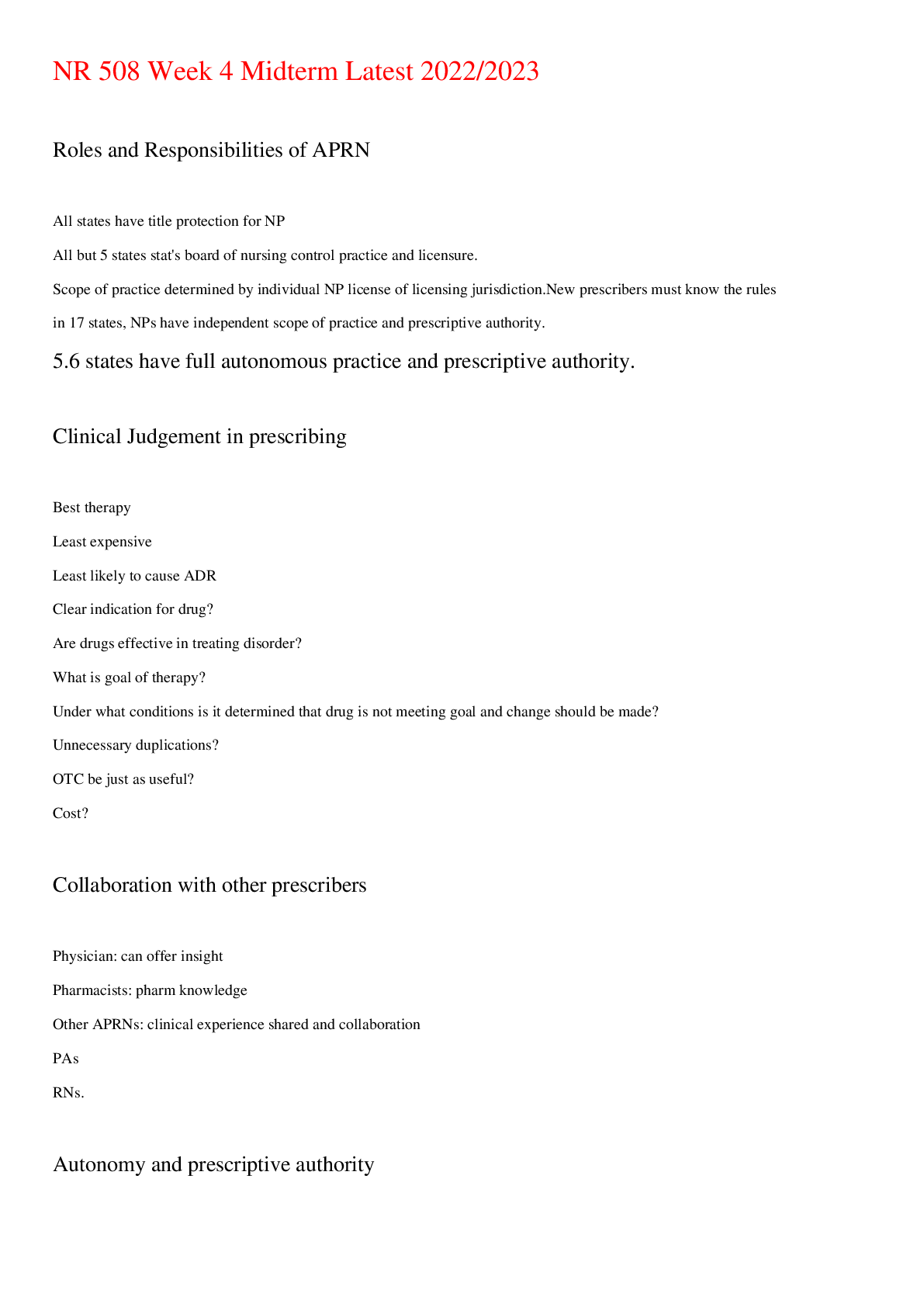
Buy this document to get the full access instantly
Instant Download Access after purchase
Add to cartInstant download
Reviews( 0 )
Document information
Connected school, study & course
About the document
Uploaded On
Apr 06, 2023
Number of pages
23
Written in
Additional information
This document has been written for:
Uploaded
Apr 06, 2023
Downloads
0
Views
19













